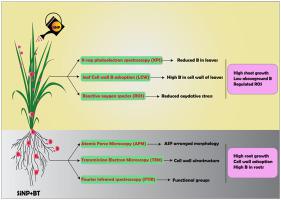Journal of Hazardous Materials ( IF 13.6 ) Pub Date : 2021-09-12 , DOI: 10.1016/j.jhazmat.2021.127175 Muhammad Riaz , Muhammad Kamran , Muhammad Rizwan , Shafaqat Ali , Xiurong Wang

|
Boron (B) toxicity is one of the limiting factors affecting plant growth. Previous studies showed that silicon (Si) application could alleviate B toxicity. However, there is limited information on how Si alleviates B toxicity in rice, particularly nano-silicon (SiNP). Therefore, the current study aimed to explore the foliar function of SiNP in the reduction of B toxicity in rice. The results showed that B toxicity significantly hampered root and shoot development. However, SiNP application increased root and shoot lengths by 14.29% and 29.67%, respectively, compared to B toxicity treatment. Moreover, SiNP increased fresh weight (FW) of root (28.02%) and shoot (34%) and enhanced dry weight (DW) of root (65.13%), and shoot (26.87%), compared to B toxicity treatment. The application of SiNP decreased the translocation of B to leaves and promoted B adsorption to leaf cell wall. In roots, SiNP triggered high B accumulation and Fourier infrared spectroscopy (FTIR) also suggested higher peak values of functional groups (pectin), indicating that cell wall polysaccharides can adsorb high concentration of B. Atomic Force Microscopy (AFM) and Transmission Electron Microscopy (TEM) investigations showed that SiNP treated roots had a well-arranged structure of alkali-soluble pectin (ASP), and ultrastructure of root was well organized. Cell wall adsorbed more than 80% of total B. All of these results suggest that SiNP can alleviate B toxicity in rice seedlings.
中文翻译:

叶面喷施硅溶胶可减轻水稻 (Oryza sativa) 幼苗的硼毒性
硼(B)毒性是影响植物生长的限制因素之一。先前的研究表明,硅 (Si) 应用可以减轻 B 毒性。然而,关于 Si 如何减轻水稻中的 B 毒性的信息有限,特别是纳米硅 (SiNP)。因此,本研究旨在探索 SiNP 在降低水稻 B 毒性中的叶面功能。结果表明,B 毒性显着阻碍了根和芽的发育。然而,与 B 毒性处理相比,SiNP 应用分别增加了 14.29% 和 29.67% 的根和芽长度。此外,与 B 毒性处理相比,SiNP 增加了根 (28.02%) 和芽 (34%) 的鲜重 (FW),并增加了根 (65.13%) 和芽 (26.87%) 的干重 (DW)。SiNP的施用减少了B向叶片的转运,促进了B向叶片细胞壁的吸附。在根中,SiNP 引发了高 B 积累,傅里叶红外光谱 (FTIR) 也表明官能团(果胶)的峰值更高,表明细胞壁多糖可以吸附高浓度的 B。原子力显微镜 (AFM) 和透射电子显微镜 ( TEM) 研究表明,SiNP 处理的根具有排列良好的碱溶性果胶 (ASP) 结构,并且根的超微结构组织良好。细胞壁吸附了 80% 以上的总 B。所有这些结果表明 SiNP 可以减轻水稻幼苗的 B 毒性。SiNP 引发的高 B 积累和傅立叶红外光谱 (FTIR) 也表明官能团(果胶)的峰值更高,表明细胞壁多糖可以吸附高浓度的 B。原子力显微镜 (AFM) 和透射电子显微镜 (TEM) 研究表明SiNP处理的根具有排列良好的碱溶性果胶(ASP)结构,并且根的超微结构组织良好。细胞壁吸附了 80% 以上的总 B。所有这些结果表明 SiNP 可以减轻水稻幼苗的 B 毒性。SiNP 引发的高 B 积累和傅立叶红外光谱 (FTIR) 也表明官能团(果胶)的峰值更高,表明细胞壁多糖可以吸附高浓度的 B。原子力显微镜 (AFM) 和透射电子显微镜 (TEM) 研究表明SiNP处理的根具有排列良好的碱溶性果胶(ASP)结构,并且根的超微结构组织良好。细胞壁吸附了 80% 以上的总 B。所有这些结果表明 SiNP 可以减轻水稻幼苗的 B 毒性。根的超微结构组织良好。细胞壁吸附了 80% 以上的总 B。所有这些结果表明 SiNP 可以减轻水稻幼苗的 B 毒性。根的超微结构组织良好。细胞壁吸附了 80% 以上的总 B。所有这些结果表明 SiNP 可以减轻水稻幼苗的 B 毒性。



























 京公网安备 11010802027423号
京公网安备 11010802027423号